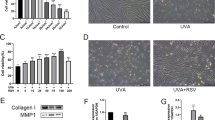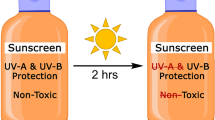Abstract
Polarity of the surrounding medium affects the excited states of UV-B sunscreens. Therefore understanding excited state processes in a mixed polarity model system similar to skin is essential. We report the excited state lifetimes, quantum yields, radiative and non-radiative rates of three sunscreens. Among the three UV-B sunscreens studied, octyl salicylate emits from a single excited state, while padimate O and octyl methoxy cinnamate show multiple states. The radiative rates of salicylate and cinnamate are approximately constant, while that of padimate O depends strongly on solvent. The non-radiative rates of all sunscreens vary with solvent polarity. Compared to salicylate and cinnamate, padimate O is complex to analyze because of its two emission peaks and one peak’s strong dependence on the dielectric constant. High absorbance, broad absorption peak with small fluorescence quantum yield, and low radiative rate make octyl methoxy cinnamate a superior UV-B sunscreen ingredient. The complexity in excited-state analysis shows that the lifetimes of the sunscreens are critical parameters, in addition to absorbance and quantum yield. Fluorescence lifetime substantiates the use of polystyrene nanospheres as a model host to study the photo-physical properties of sunscreen in a heterogeneous environment.













Similar content being viewed by others
References
Azevedo JS, Viana NS Jr, Soares CD (1999) UVA/UVB sunscreen determination by second-order derivative ultraviolet spectrophotometry. Farmaco 54:573–578
Maier H, Schauberger G, Brunnhofer K, Honigsmann H (2001) Change of ultraviolet absorbance of sunscreens by exposure to solarsimulated radiation. J Investig Dermatol 117:256–262
Rosenstein BS, Weinstock MA, Habib R (1999) Transmittance spectra and theoretical sun protection factors for a series of sunscreen-containing sun care products. Photodermatol Photoimmunol Photomed 15:75–80
Serpone N, Salinaro A, Emeline AV, Horikoshi S, Hidaka H, Zhao J (2002) An in vitro systematic spectroscopic examination of the photostabilities of a random set of commercial sunscreen lotions and their chemical UVB/UVA active agents. Photochem Photobiol Sci 1:970–981
Lowe NJ (1997) Sunscreens: development, evaluation, and regulatory aspects, cosmetic science and technology series, 2nd edn. Marcel Dekker, New York
Beyere L, Yarasi S, Loppnow GR (2003) Solvent effects on sunscreen active ingredients using Raman spectroscopy. J Raman Spectrosc 34:743–750
Schlumpf M, Cotton B, Conscience M, Haller V, Steinmann B, Lichtensteiger W (2001) In vitro and in vivo estrogenicity of uv screens. Environ Health Perspect 109:239–244
Gupta VK, Zatz JL, Rerek M (1999) Percutaneous absorption of sunscreens through micro-yucatan pig skin in vitro. Pharm Res 16:1602–1607
Krishnan R, Carr A, Blair E, Nordlund TM (2004) Optical spectroscopy of hydrophobic sunscreen molecules adsorbed to dielectric nanospheres. Photochem Photobiol 79:531–539
Krishnan R, Pradhan S, Timares L, Katiyar SK, Elmets CA, Nordlund TM (2006) Fluorescence of sunscreens adsorbed to dielectric nanospheres: parallels to optical behavior on HaCat cells and skin. Photochem Photobiol 82:1557–1565
Krishnan R, Elmets CA, Nordlund TM (2006) New method to test the effectiveness of sunscreen ingredients in a novel nano-surface skin cell mimic. Photochem Photobiol 82:1549–1556
Lakowicz JR (1999) Principles of fluorescence spectroscopy, 2nd edn. Plenum, New York
Strickler SJ, Berg RA (1962) Relationship between absorption intensity and fluorescence lifetime of molecules. J Chem Phys 37(4):814–822
Zhang CH, Chen ZB, Jiang YB (2004) Intramolecular charge transfer dual fluorescence of p-dimethylaminobenzoates. Spectrochimica Acta A 60:2729–2732
Sun YP, Bowen TL, Bunker CE (1994) Formation and decay of the ethyl p-(N,N-dimethylamino)benzoate twisted intramolecular charge transfer stated in the vapor phase, supercritical fluids and room temperature solutions. J Phys Chem 98:12486–12494
Kim YH, Cho DW, Yoon M (1996) Observation of hydrogen bonding effects on twisted intramolecular charge transfer of p-(N,N-dimethylamino)benzoic acid in aqueous cyclodextrin solutions. J Phys Chem 100:15670–15676
Nag A, Dutta R, Chattopadhyay N, Bhattacharyya K (1989) Effect of cyclodextrine cavity size on twisted intramolecular charge transfer emission: dimethylamino benzonitrile in β-cyclodextrine. Chem Phys Lett 157:83–86
Soujanya T, Saroja G, Samata A (1995) AM1 study of the twisted intramolecular charge transfer phenomenon in p-(N, N-dimethylamino)benzonitrile. Chem Phys Lett 236:503–509
Hicks JM, Vandersall MT, Babarogic Z, Eisenthal KB (1985) The dynamics of barrier crossings in solution: the effect of solvent polarity dependent barrier. Chem Phys Lett 116:18–24
Wang Y, Eisenthal KB (1982) Picosecond dynamics of twisted internal charge transfer phenomena. The role of solvent. J Chem Phys 77:6076–6082
Jean JM, Hall KB (2000) Theoretical studies of excited state properties and transitions of 2-aminopurine in the gas phase and in solution. J Phys Chem A 104:1930–1937
Cox GS, Turro NJ (1984) Methyl salicylate fluorescence as a probe of the geometry of complexation to cyclodextrins. Photochem Photobiol 40:185–188
Smith KK, Kaufmann KJ (1981) Solvent dependence of the nonradiative decay rate of methyl salicylate. J Phys Chem 85:2895–2897
Smith KK, Kaufmann KJ (1978) Picosecond studies of intramolecular proton transfer. J Phys Chem 82:2286–2291
Friedrich DM, Wang Z, Joly AG, Peterson KA, Callis PR (1999) Ground-state proton-transfer tautomer of the salicylate anion. J Phys Chem A 103:9644–9653
Artyukhov VYa, Smirnov OV (2003) Investigation of dual fluorescence in 4-dimethylamino benzonitrile. Rus Phys J 46:484–487
Artyukhov VYa, Smirnov OV (2004) Dual fluorescence in donor-acceptor molecules and the effect of fluorination. Rus Phys J 47:983–987
Acknowledgements
Supported in part by a grants from NCI (CA94327) and from the University of Alabama at Birmingham (Preparing Future Faculty award and GAPF graduate fellowship, support of R. K.).
Author information
Authors and Affiliations
Corresponding author
Rights and permissions
About this article
Cite this article
Krishnan, R., Nordlund, T.M. Fluorescence Dynamics of Three UV-B Sunscreens. J Fluoresc 18, 203–217 (2008). https://doi.org/10.1007/s10895-007-0264-3
Received:
Accepted:
Published:
Issue Date:
DOI: https://doi.org/10.1007/s10895-007-0264-3




